Written by Team Expique
Published: September 15, 2022
Ayutthaya offers a wealth of attractions to discover, from ancient temples and majestic palaces to vibrant markets and delicious local cuisine. In our comprehensive guide to Ayutthaya, we’ve compiled everything you need to know for an enjoyable visit. Browse the sections below for direct access to the information you seek:
The History of Ayutthaya
Ayutthaya was the second capital of Siam, the historical name of present-day Thailand, with Sukhothai being the first capital situated to the north. Established around 1350, Ayutthaya was part of the Sukhothai Kingdom and quickly became an important trading hub with foreign nations. By 1378, as the Sukhothai Kingdom began to decline, Ayutthaya emerged as a bustling urban center, eventually serving as the longest-lasting capital in Thai history.
Once a global trading hub, Ayutthaya was one of the largest cosmopolitan cities of its time, adorned with splendid temples, grand palaces, and scenic waterways, nestled between three rivers: the Chao Phraya, Pa Sak, and Lopburi Rivers. These rivers provided natural defenses against invasions, while canals facilitated transportation, earning Ayutthaya the nickname “Venice of Asia.”
The city thrived for 417 years until it was devastated by the Burmese army in 1767, causing widespread destruction and forcing the royal family and residents to flee to Burma. Following the siege, King Taksin led a successful campaign to reclaim the city, but opted to establish a new capital in Krung Thonburi across the Chao Phraya River, largely because of Ayutthaya’s significant damage and strategic vulnerability to future attacks.
Today, Ayutthaya is a UNESCO World Heritage Site, attracting numerous tourists who can explore its historic attractions independently.
Explore Ayutthaya: Temples in the Historical Park
Located approximately 80 kilometers from Bangkok, Ayutthaya is a perfect destination for a day trip. The Ayutthaya Historical Park houses temple ruins and museums that provide valuable insights into the city’s storied past.
Wat Phra Si Sanphet
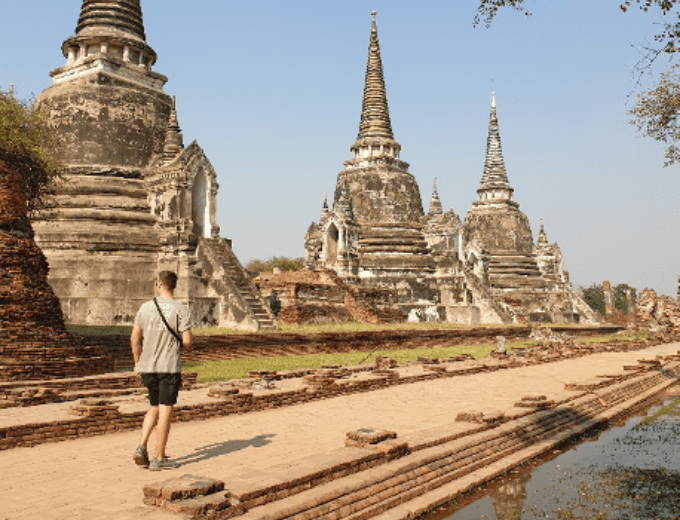
Wat Phra Si Sanphet was the most significant temple during the Ayutthaya period, situated within the royal palace complex. It was the original home of the Emerald Buddha, now housed in Bangkok’s Grand Palace.
Construction of this temple spanned several reigns, beginning with King U Thong, the first king of Ayutthaya. Approximately 90 years later, during King Ramathibodi II’s reign, the iconic large pagodas were erected to honor the ashes of his father and elder brother. Additional large pagodas were built three decades later for King Ramathibodi II’s ashes under the orders of King Narai the Great, who also commissioned a grand sermon hall known as ‘viharn.’ Unfortunately, the viharn was destroyed during conflicts, leaving only the massive pagodas that stand today, stripped of their original gold coverings.
Notably, Wat Phra Si Sanphet once housed a magnificent 16-meter gilded statue of the standing Buddha named Phra Si Sanphet, covered in 340 kilograms of gold and located in the royal assembly hall. When the temple was attacked, the gold was melted down and taken to Burma, while the remaining bronze core was relocated to Bangkok and restored at Wat Pho.
Opening hours: 08:00 – 18:30
Entrance fee: 50 THB
Wat Mahathat
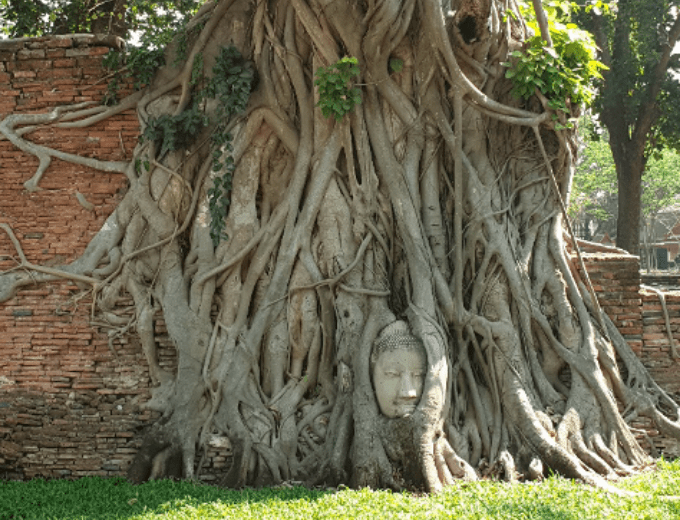
Wat Mahathat, known as ‘the temple of the great relic,’ was among the most important temples close to the palace, enshrining sacred Buddha relics and serving as the residence of the Supreme Patriarch, the leader of Thai Buddhist monks during that era.
This temple reflects Khmer architectural influences, featuring prangs (tower-like structures), assembly halls, and ordination halls, all designed based on Hindu and Buddhist cosmological concepts during King Boromma Rachathirat I’s reign, marking the inception of the Ayutthaya period. The central prang was constructed to house the Buddha relic. Unfortunately, it collapsed during the last war, and although it was rebuilt, it again collapsed when set ablaze. Since then, no restoration has occurred, leaving the temple in its current state.
Wat Mahathat is now famous for the Buddha head entwined in a tree root—a mystery that has intrigued many. It is one theory suggests that a thief cut off the head of the Buddha statue and hid it within the tree, which gradually grew to envelop it over time.
Opening hours: 08:00 – 18:30
Entrance fee: 50 THB
Wat Ratchaburana
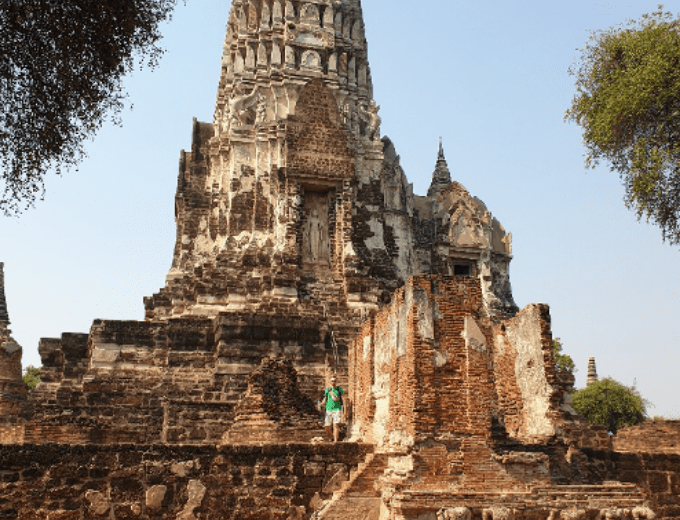
Wat Ratchaburana was constructed early in the Ayutthaya period under King Sam Phraya to honor his two older brothers who perished in a battle for the throne after their father’s death. The temple was built on the site of their cremation.
The entrance features the main shrine (ubosot), with remnants of walls and damaged pillars still visible. Though the roof is long gone, it allows for a unique view of the central prang, designed in the Khmer style. Hidden within the prang was a crypt that remained undiscovered until 1957 when it was looted. Adventurers found treasures including golden Buddha images, tablets, royal regalia, and exquisite murals.
After the crypt’s discovery, the Fine Arts Department restored the temple, relocating some treasures to the Chao Sam Phraya National Museum. Many of the stolen items were returned after thieves reported eerie experiences, believed to be linked to a curse.
Opening hours: 08:00 – 18:30
Entrance fee: 50 THB
Wat Chaiwatthanaram
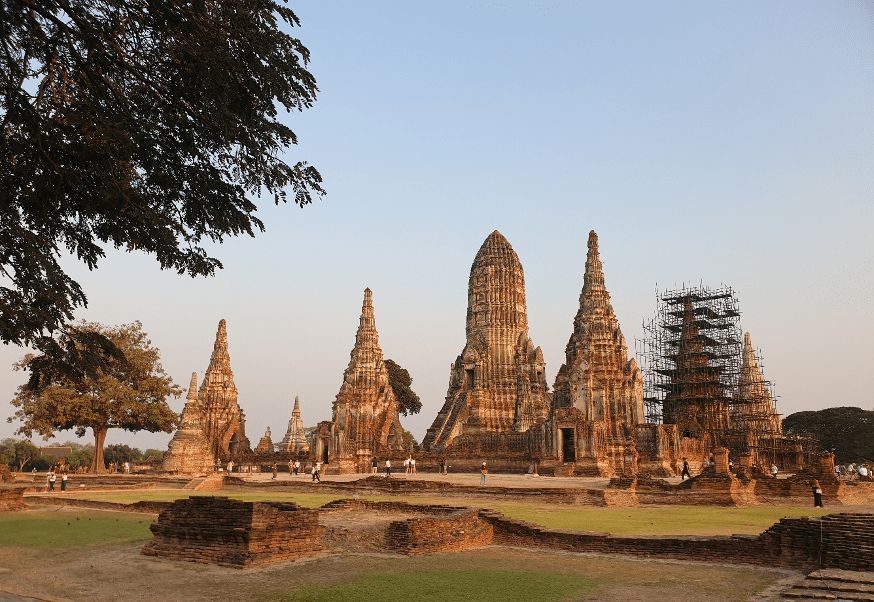
Wat Chaiwatthanaram is a royal temple located by the riverbank outside the historical island. Constructed in 1630 under King Prasat Thong, this temple commemorated his mother and celebrated victory in the war against the Khmer. Its architecture is inspired by the mountain temples of Angkor, reflecting Buddhist and Hindu cosmology.
The main prang is believed to house relics of the Buddha, while several smaller prangs contain the ashes of the royal family, including that of Crown Prince Chao Fah Goong, who was executed alongside a consort due to accusations of infidelity.
During the Burmese invasion, the temple served as a camp for the Burmese army. After the kingdom’s fall, it was abandoned and fell to ruin. Restoration efforts began in 1987, and today, Wat Chaiwatthanaram stands out as one of the most stunning temples in Ayutthaya.
Opening hours: 08:00 – 18:30
Entrance fee: 50 THB
Wat Lokaya Sutha
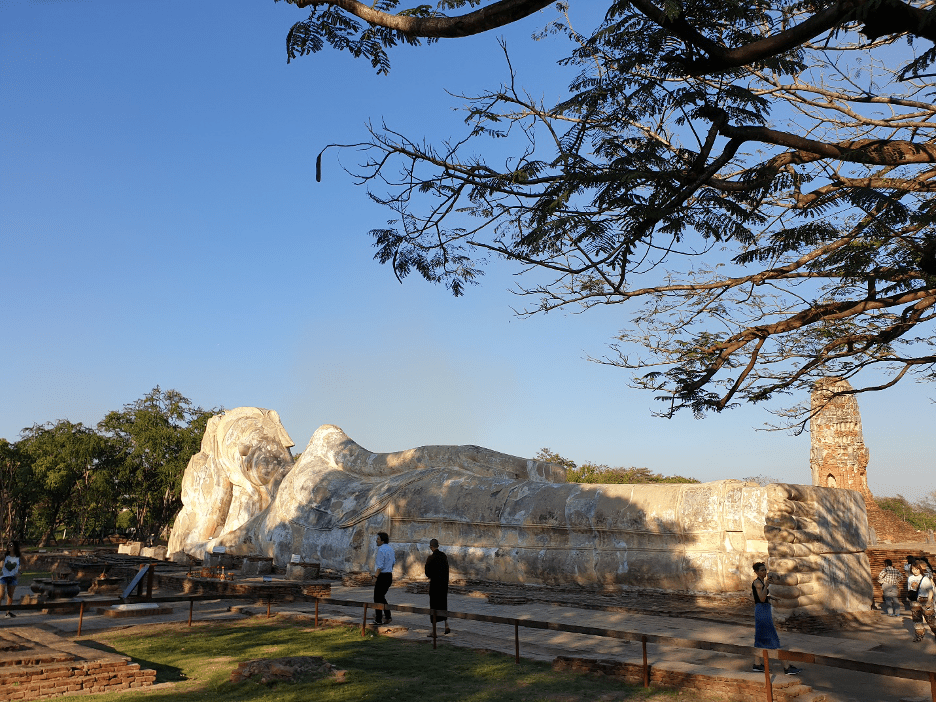
Highlighting this temple is the largest reclining Buddha image in Ayutthaya, measuring 42 meters long and 8 meters high, typically draped in orange fabric. Built during the height of the Ayutthaya period, the temple’s exact history remains unclear, but its location near the ancient palace signifies its importance.
Opening hours: 08:00 – 18:30
Entrance fee: Free
Wat Phra Ram
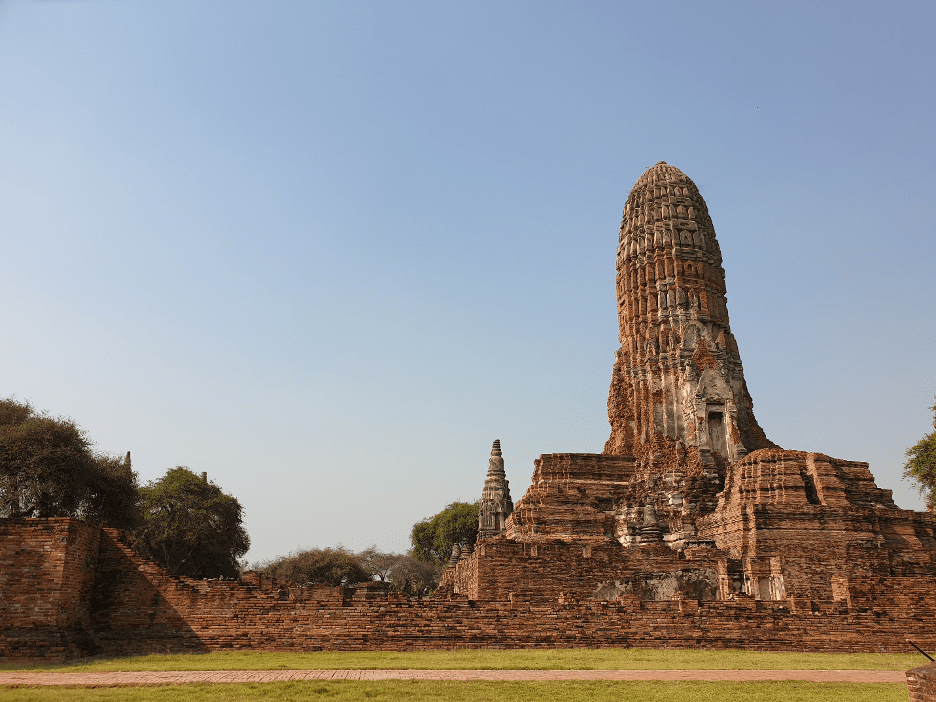
Built early in the Ayutthaya period, Wat Phra Ram is situated at the cremation site of King U-Thong, the first king of the Ayutthaya Kingdom. Although it’s centrally located in Ayutthaya Historical Park, it often goes unnoticed by tourists heading to the more famous temples nearby, such as Wat Mahathat and Wat Phra Si Sanphet.
Constructed in Khmer style, the main prang is well-preserved and surrounded by smaller pagodas and stupas. This temple offers a peaceful atmosphere compared to the more crowded ruins in the area.
Opening hours: 08:00 – 18:30
Entrance fee: 50 THB
Wat Phanan Choeng
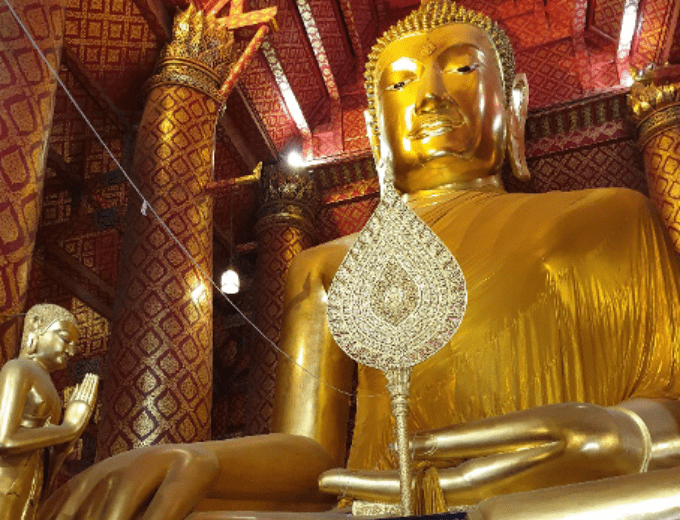
Also known as ‘Wat Laung Po To,’ this temple features an enormous seated Buddha, elegantly positioned in the subduing Mara posture. Historically, the temple was built long before the city’s founding, making it one of the oldest structures in Ayutthaya, although the original building has likely deteriorated over time and conflict. Today, a sizable hall surrounds the Buddha image.
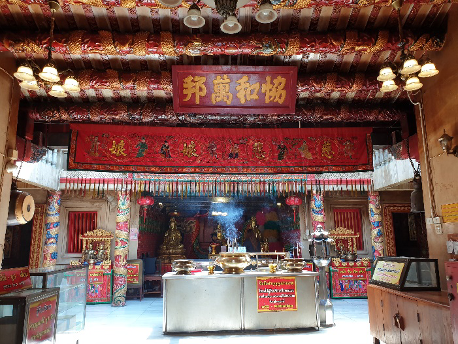
Legend has it that a Chinese princess, known as Soi Dok Mak, played a significant role in the temple’s history. She was sent to marry a king in Ayutthaya but, upon arrival and awaiting his presence, tragically ended her own life. Struck with grief, the king built this temple at the site of her cremation.
Today, a small Chinese shrine near the temple venerates Guanyin, the Goddess of Mercy, on the first floor, while the second floor features a statue representative of Princess Soi Dok Mak.
This massive Buddha image is also called ‘Som Bo Kong,’ symbolizing good fortune in sailing, thus attracting both Thai and Chinese visitors.
Opening hours: 08:00 – 17:00
Entrance fee: 20 THB
Wat Yai Chai Mongkhon
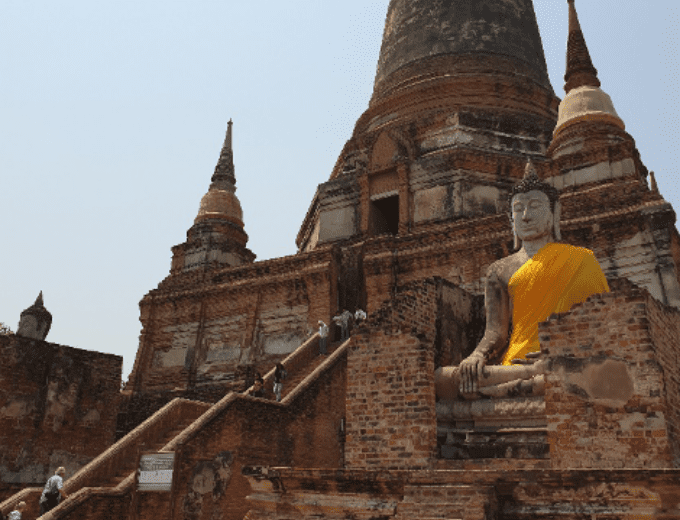
Situated east of Ayutthaya Historical Park, approximately a ten-minute drive from the temple ruins, Wat Yai Chai Mongkhon is highly recommended by visitors. An active temple where monks reside, the highlight is a towering stupa offering panoramic views of the complex.
Founded during the early Ayutthaya Kingdom under King U Thong, the initial construction included small chedis and an assembly hall for the Supreme Patriarch of the forest sect of Buddhism. Originally named Wat Pa Keaw, the temple was later transformed under King Naresuan the Great, who commissioned the massive stupa to commemorate his victory over the Burmese army.
This temple became the site of a legendary battle where King Naresuan fought the Burmese Crown Prince on elephants. Following his return, he chose to forgive the soldiers who had failed to support him, instead opting to build a pagoda in memory of his triumph, which is now called Wat Yai Chai Mongkhon.
Opening hours: 08:00 – 18:00
Entrance fee: 20 THB
Wat Putthai Sawan
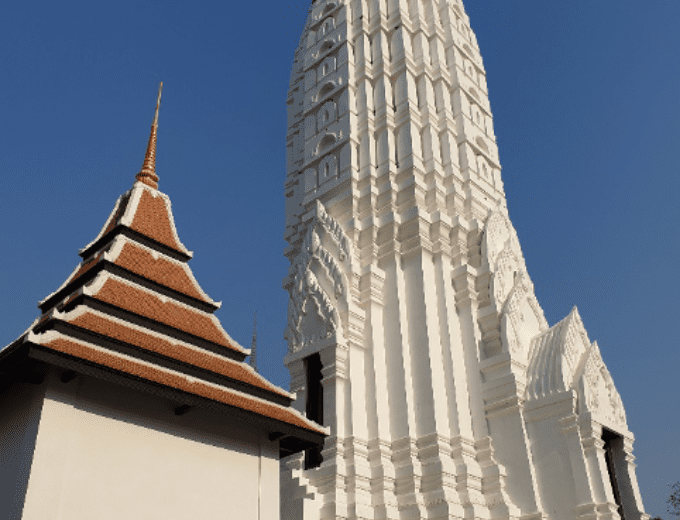
Located across the river from Ayutthaya Historical Park, Wat Putthai Sawan is conveniently visited alongside Wat Chaiwattanaram on the same riverbank. Built during the early Ayutthaya Kingdom under King U Thong, the temple honors his elder brother who triumphed over the Khmers and brought countless Khmer people back to Ayutthaya. The main prang showcases traditional Khmer architecture.
Once a renowned martial arts school, this temple has gained popularity due to its appearance in television shows, where visitors enjoy capturing photos in traditional attire against its backdrop. It’s also famed for local lucky charms, amulets, and votive tablets, with a notable statue of Buddha subduing Mara housed inside the ordination hall.
Opening hours: 08:00 – 17:00
Entrance fee: None
Chao Sam Phraya National Museum
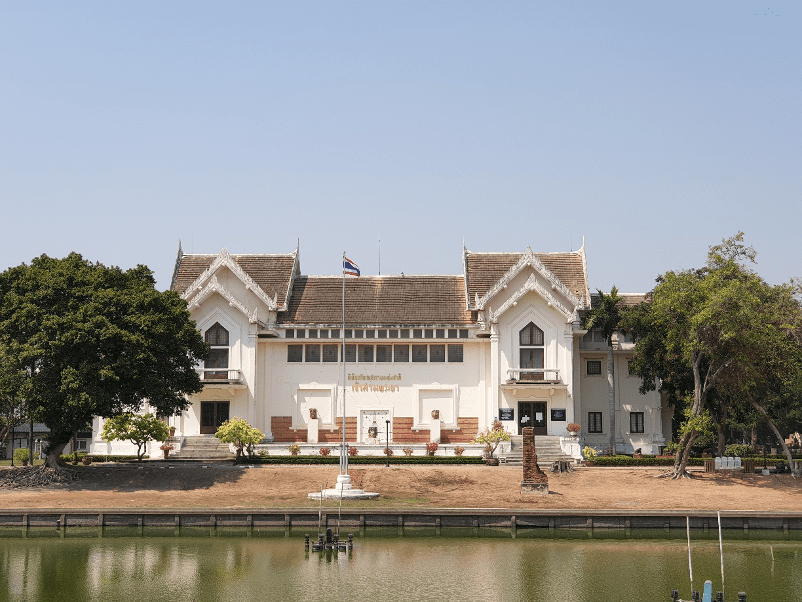
The Chao Sam Phraya National Museum is the most significant museum in Ayutthaya, officially inaugurated in 1961. It showcases thousands of artifacts, including Buddha statues, votive tablets, golden relics, and treasures retrieved from the crypts of various temples, particularly valuable items from Wat Ratchaburana.
The museum’s exhibitions are housed across three buildings, with the main building featuring an excellent collection of treasures, including gold artifacts, royal insignia, and elaborately crafted jewelry from Wat Ratchaburana and Wat Mahathat.
Gold artifacts are displayed in an air-conditioned area with modern presentation, and all items are labeled in both Thai and English. A separate room is designated for the Buddha relics found in the crypts of Wat Mahathat.
Photography is not permitted inside the exhibition area.
Traveling Guidelines in the Ayutthaya Historical Area
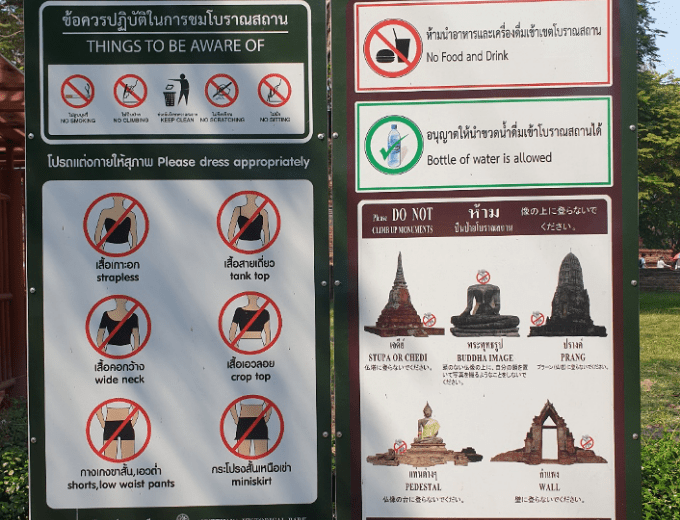
Please Note:
- No Smoking
- Keep the area Clean
- No Scratching of artifacts
- No sitting or climbing on monuments
- Food and drink are prohibited; however, water is allowed
Opening hours: 09:00 – 16:00
Entrance fee: 150 THB ** Closed on Mondays **
Additional Activities and Attractions in Ayutthaya
Bang Pa-In Palace
About 24 km from Ayutthaya lies the Bang Pa-In Royal Palace, also known as Bang Pa-In Summer Palace. Originally constructed in the 17th century by King Prasat Thong, it was later refurbished in the 19th century by King Mongkut (King Rama IV).
Visitors can admire various architectural styles within the complex for an entrance fee of 100 THB per person. The blend of classical Thai, Chinese, and European influences set against well-maintained lawns creates an ideal backdrop for photography. The palace is open from 08:30 AM to 4:00 PM, allowing ample time to appreciate its historical and architectural significance. Remarkably, there are few palaces where one can rent a gold cart for exploring the grounds—available for 450 THB for the first hour and 100 THB for each additional hour.
As a summer palace, there is a dress code; appropriate attire is essential for entry. Visitors are urged to cover their knees and shoulders; denim with conspicuous patterns is not permitted. For those underdressed, affordable rental services are available outside the palace.
Opening hours: 08:30 – 16:00
Entrance fee: 100 THB
Bang Sai Arts and Craftsman Centre
Perched along the banks of the Chao Phraya River, the Bang Sai Museum was inaugurated in 1984 under the patronage of Her Majesty Queen Sirikit. This large facility acts as a hub for teaching and establishing skills in traditional Thai craftsmanship, aiming to promote employment opportunities for local artisans. Various exhibition buildings are dedicated to crafts such as weaving, ceramics, and Khon mask production, among others.
The museum also houses a bird park and fish aquarium for an enjoyable family day out. Admission fees are 100 THB for adults and 50 THB for children, making it a family-friendly outing from 8:30 AM to 5:00 PM.
Must-Try Dishes in Ayutthaya
In Ayutthaya, if you ask locals about their favorite dish, many will mention boat noodles or ‘kuay teaw rue.’
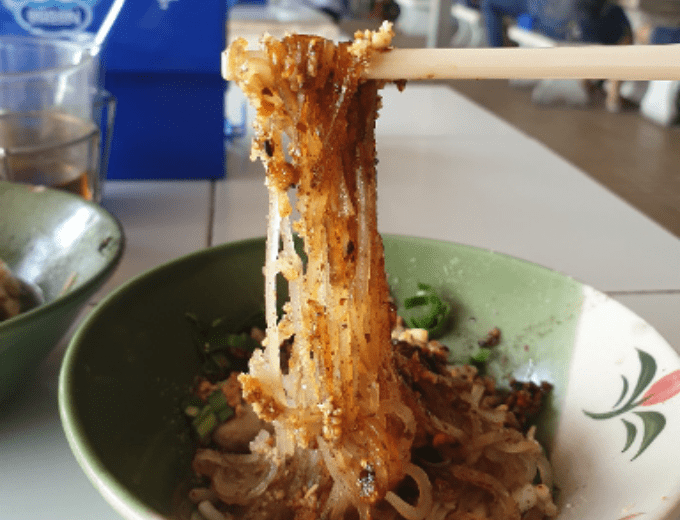
Boat noodles are served in small portions, often requiring customers to order multiple dishes (5-10) for a complete meal. This unique noodle soup distinguishes itself by incorporating blood, resulting in a thick and hearty flavor.
The term ‘boat noodles’ derives from the traditional method of delivery—served via boats that traversed the canals connecting homes. Although canals are less utilized for transport today due to urban development, numerous boat noodle shops retain the name and often feature boats as decorative elements.
Ayutthaya boasts more than a hundred boat noodle restaurants, but none is more famous than Aunty Lek Boat Noodle (Kuay Teaw Rue Pa Lek), celebrated as the birthplace of authentic Ayutthaya boat noodles.
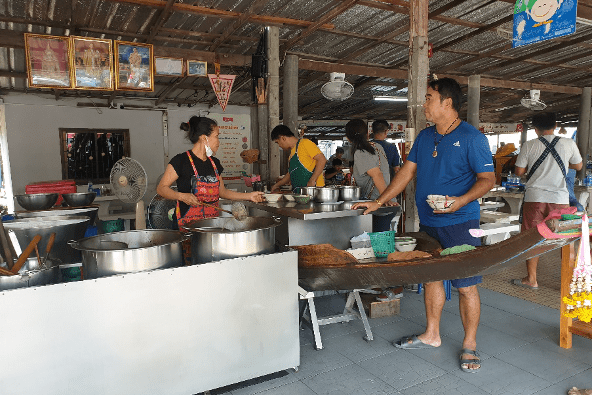
Location: Opposite Wat Mahathat
Opening hours: 08:00 – 17:00 daily
Price: 15-20 THB/dish
Additionally, visitors should try ‘roti sai mai,’ a popular dessert made of candy floss or cotton candy rolled in paper-thin roti sheets.
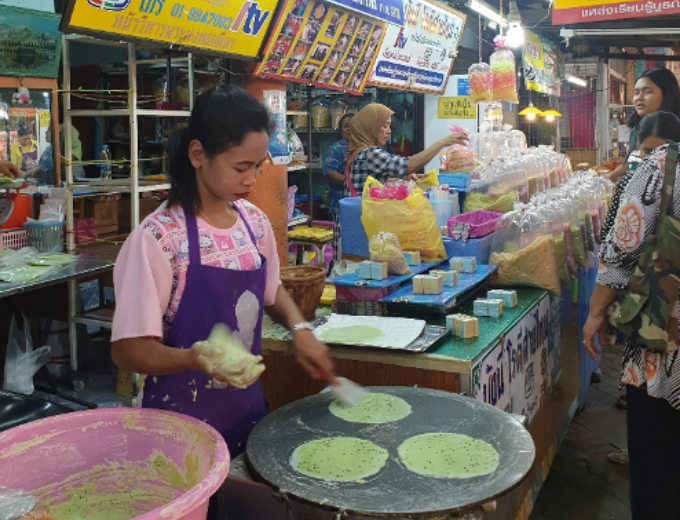
This treat is widely available at street stalls throughout the city. Rooted in a Muslim recipe, ‘roti sai mai’ was traditionally made and sold by Muslim vendors before becoming a beloved snack among locals and tourists.
How to Reach Ayutthaya
Ayutthaya lies approximately 80 km north of Bangkok along the Chao Phraya River, accessible by various modes of transport.
By Train
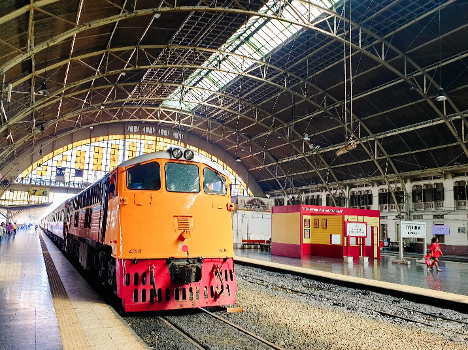
Trains to Ayutthaya depart regularly from Hua Lamphong station. Online booking is available at least two hours before departure through the State Railway of Thailand’s official website:
The site offers competitive prices but can be somewhat tricky to navigate. Additionally, other private websites also offer tickets but may charge a higher markup.
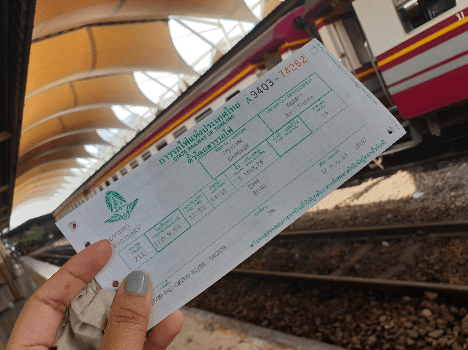
Train fares vary by class and speed (Special Express, Express, Rapid). Both first and second-class tickets can be booked online, while third-class (Ordinary Train) tickets are only available for purchase on the day of travel, paid in cash.
Pricing for train travel is as follows:
- Ordinary Train: 15 THB
- Rapid Train: 45-65 THB
- Express Train: 165-245 THB
- Special Express Train: 345 THB
Daily Train Schedule: Bangkok – Ayutthaya
| Train Number | Type | Bangkok Departure | Ayutthaya Arrival | ||
| 303 | Ordinary | 04:20 | 05:48 | ||
| 339 | Ordinary | 05:20 | 06:44 | ||
| 21 | Special Express | 05:45 | 06:58 | ||
| 135 | Rapid | 06:40 | 08:25 | ||
| 111 | Rapid | 07:00 | 08:37 | ||
| 75 | Express | 08:20 | 09:41 | ||
| 7 | Special Express | 08:30 | 09:47 | ||
| 201 | Ordinary | 09:25 | 11:27 | ||
| 71 | Express | 10:05 | 11:24 | ||
| 3 | Special Express | 10:50 | 12:15 | ||
| 209 | Ordinary | 11:20 | 13:04 | ||
| 233 | Ordinary | 11:40 | 13:06 | ||
| 211 | Ordinary | 12:55 | 14:31 | ||
| 109 | Rapid | 13:45 | 15:17 | ||
| 207 | Ordinary | 14:05 | 15:57 | ||
| 145 | Rapid | 15:20 | 16:56 | ||
| 301 | Ordinary | 16:30 | 18:32 | ||
| 341 | Ordinary | 17:00 | 18:57 | ||
| 317 | Ordinary | 17:25 | 19:12 | ||
| 9 | 18:10 | 19:44 | |||
| 313 | Ordinary | 18:20 | 20:18 | ||
| 77 | Express | 18:35 | 20:03 | ||
| 139 | Rapid | 18:55 | 20:25 | ||
| 13 | Special Express | 19:35 | 21:06 | ||
| 25 | 20:00 | 21:40 | |||
| 107 | Rapid | 20:10 | 21:43 | ||
| 23 | 20:30 | 21:52 | |||
| 133 | Rapid | 20:45 | 22:17 | ||
| 105 | Rapid | 21:00 | 22:22 | ||
| 67 | Express | 21:30 | 22:50 | ||
| 51 | Express | 22:00 | 23:35 | ||
| 141 | Rapid | 22:45 | 00:16 |
Ayutthaya Train Station:
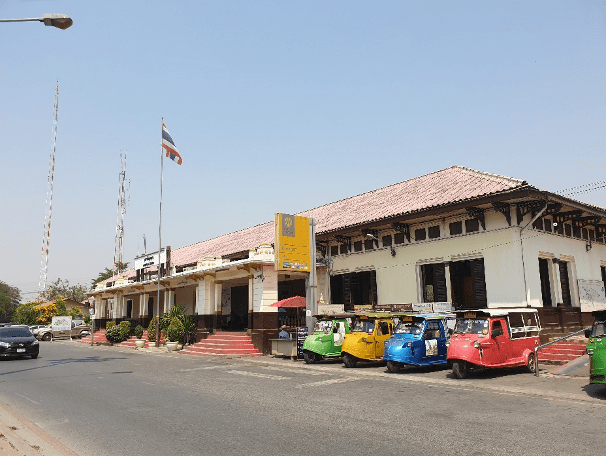
Ayutthaya Train Station is approximately a ten-minute distance from the historical park. For luggage, we recommend using a tuk-tuk or Grab.
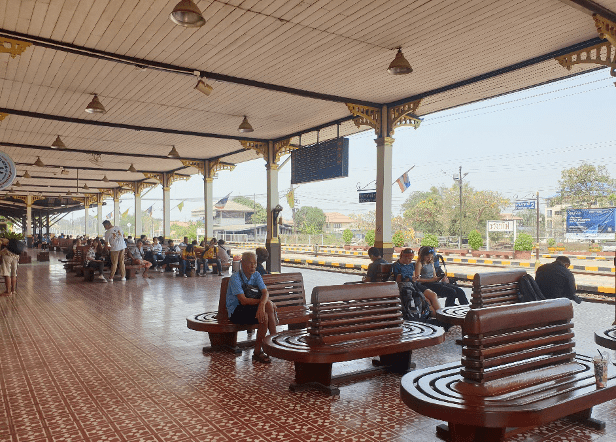
Trains to Bangkok depart on a daily basis from Ayutthaya Train Station, which operates 24 hours. The first train leaves at 2:00 AM and the final train at 9:00 PM. Facilities include free Wi-Fi, an ATM, a coffee shop, public phones, toilets, and a 7-11 convenience store nearby.
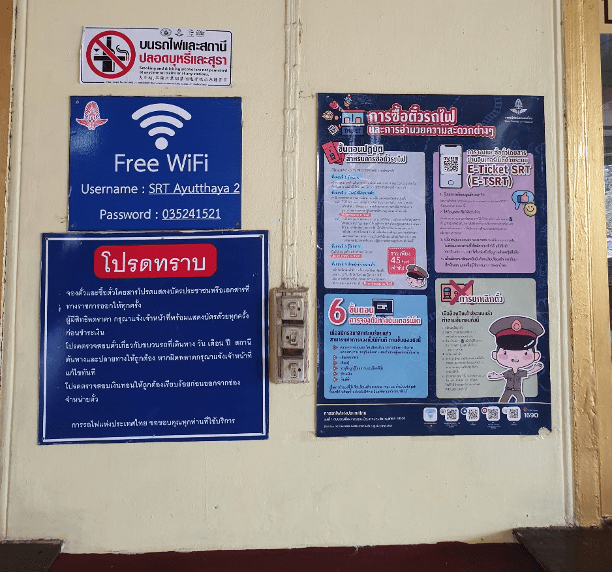
The station itself does not have air conditioning but offers ample seating in spacious areas.
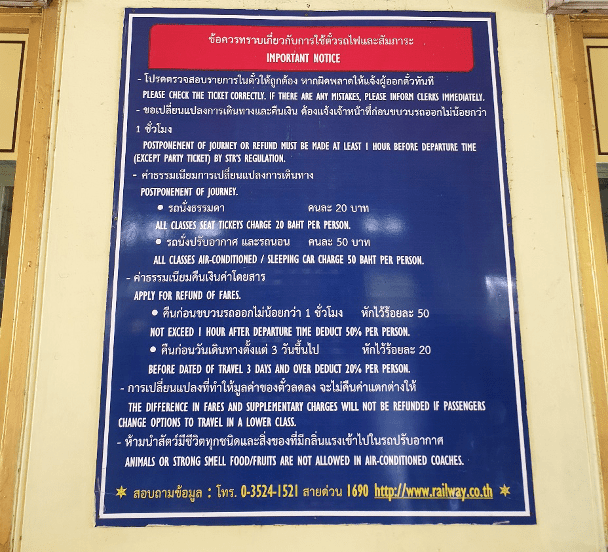
By Minibus (Van)
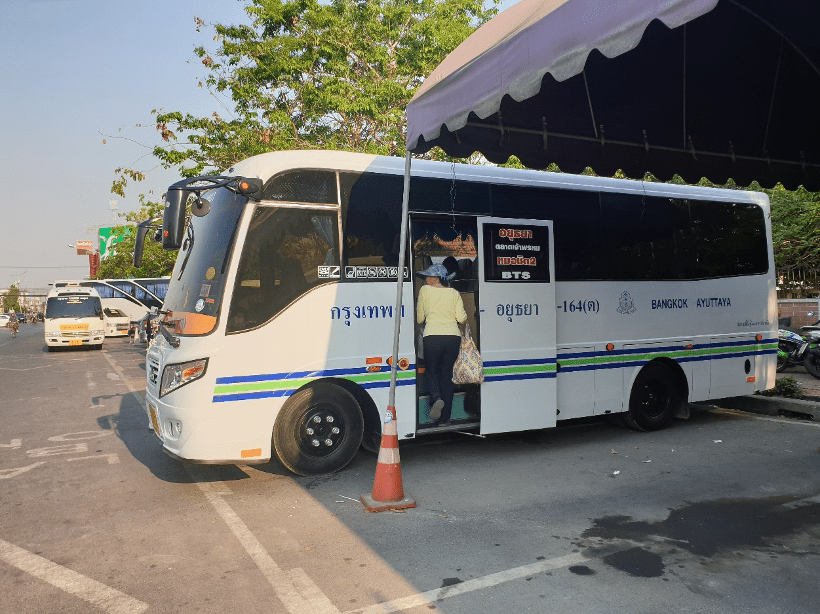
Minibuses frequently depart from Mo Chit Bus Terminal in northern Bangkok and transport passengers to downtown Ayutthaya at Talad Chaoprom Market, conveniently close to Ayutthaya Historical Park. Buses run every 20-30 minutes.
Operating hours:
Bangkok – Ayutthaya: 06:00 – 20:00
Ayutthaya – Bangkok: 04:00 – 18:00
Fare: 70 THB
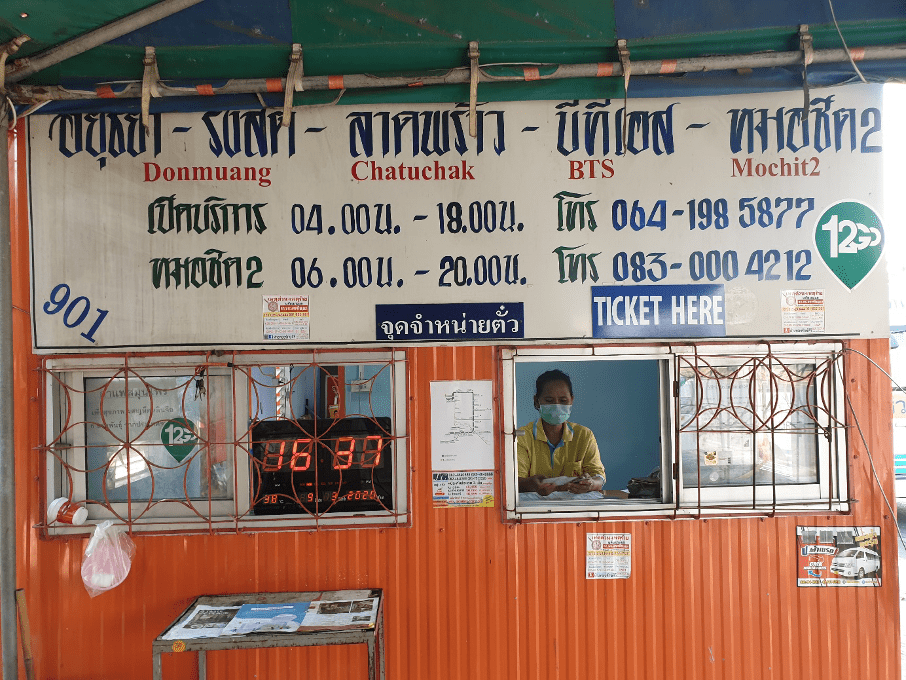
If you’re starting your journey from downtown Bangkok, taking the BTS Skytrain or MRT underground train is the most efficient way to reach Mo Chit Bus Terminal and avoid traffic.
By BTS Skytrain Station
Disembark at Mo Chit Station and opt for a taxi or motorbike taxi to reach the bus terminal.
By MRT Underground Train
Arrive at Kamphaeng Phet MRT station and take a taxi or motorbike taxi to reach Mo Chit Bus Terminal.
Taxi or Grab
This option is the most convenient, providing door-to-door service from your accommodation and is generally the fastest method to reach Ayutthaya. Prices vary depending on your pickup location and destination, typically ranging from 1,100 to 1,500 THB for a one-way trip.
Most taxis can accommodate 3-4 passengers, making it a great option if you’re traveling with a group.
Getting Around Ayutthaya
The roads in Ayutthaya are well-connected and generally have less traffic. Given the proximity of historical sites, you can explore the area even without a private vehicle:
Bicycle or Motorcycle Rental
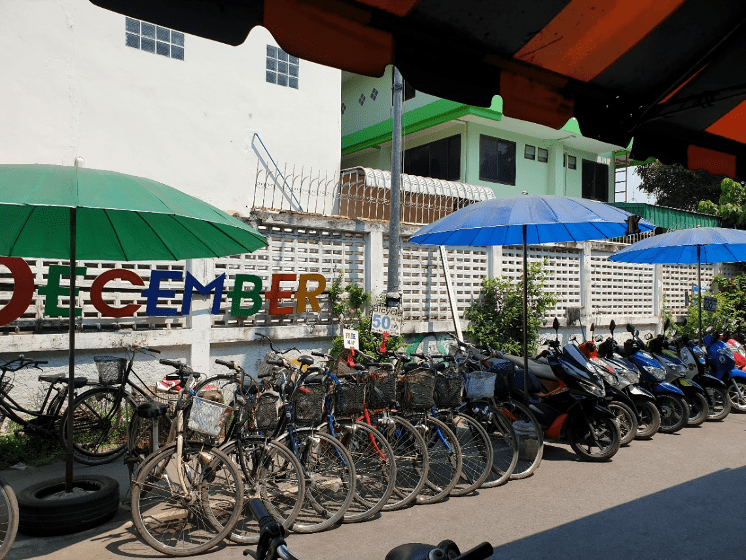
Numerous shops offer rental services, especially around the train and bus stations, and an international driving license is typically not required.
To rent: You’ll need to provide your original passport as a deposit or 3,000 THB along with an ID card.
Rental prices:
Daily (return by 18:00): Bicycle: 50 THB; Motorcycle: 200 THB
Overnight (24 hours): Bicycle: 80 THB; Motorcycle: 300 THB
Motorcycle Taxis
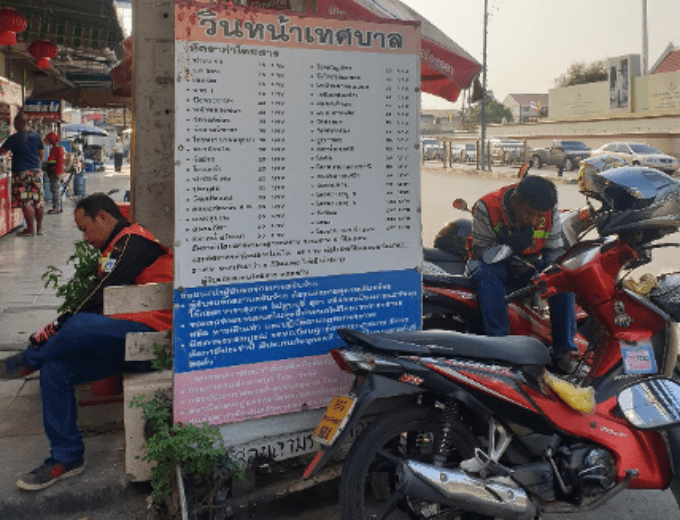
This is the quickest way to navigate the city with a local driver. Motorcycle taxis are easily identifiable by their orange uniforms and are typically found in bustling areas. They charge fares based on distance but can also be hired for tours at a rate of 200-300 THB per hour.
Tuk Tuks
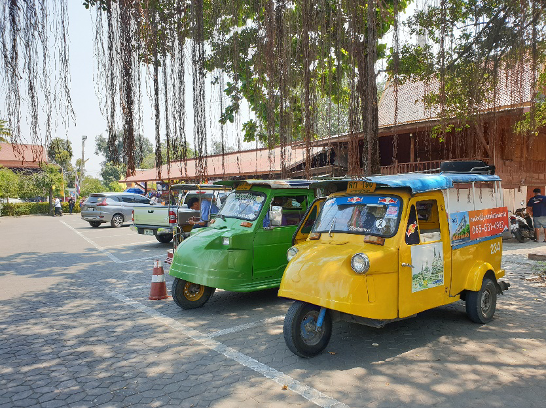
Tuk-tuks tend to congregate near popular tourist spots, with prices varying based on starting points. They typically operate on a point-to-point basis.
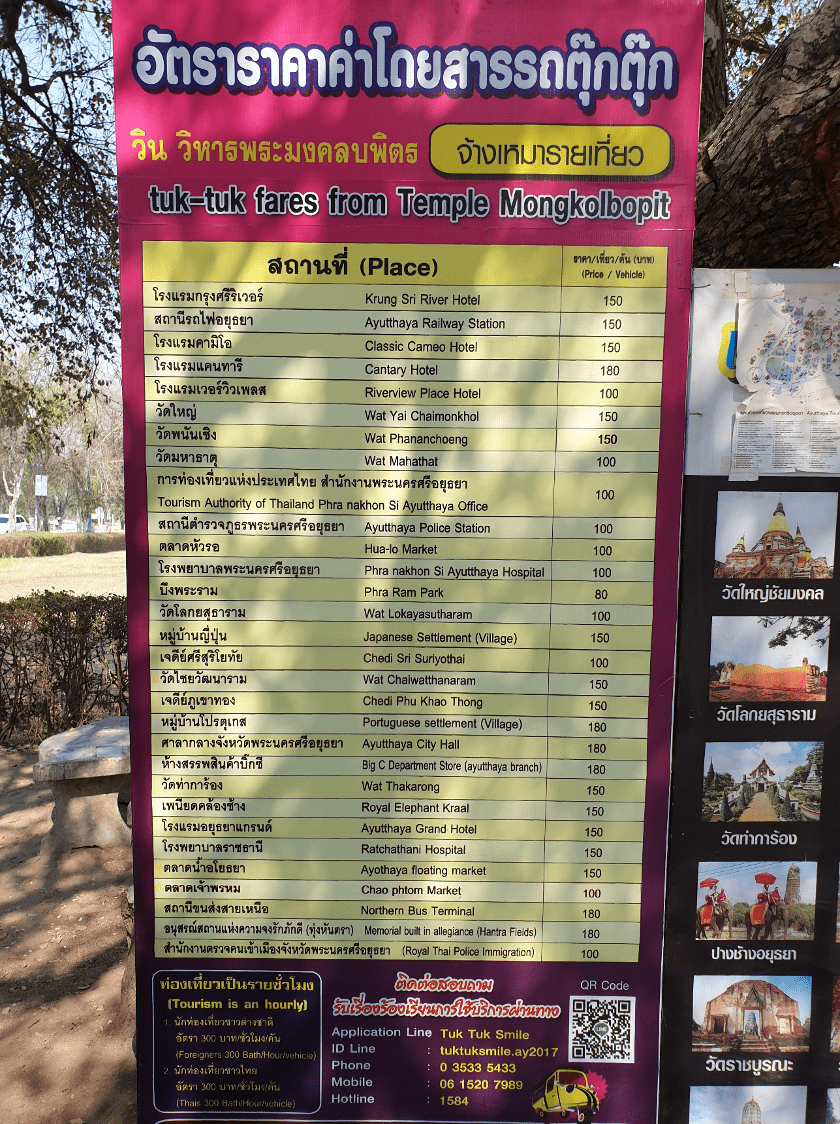
To hire one for a few hours of temple exploration, expect to pay around 300 THB per hour. If quoted a higher price, feel free to negotiate.
Consider Taking a Tour of Ayutthaya
Ayutthaya serves as a fantastic day trip from Bangkok. At Expique, we offer personalized tours, including our exciting “Ayutthaya Adventure.” Be sure to check it out!
Additional Articles You Might Find Interesting
Explore Thailand with Expique
At Expique, we aim to help visitors discover the authentic Bangkok and its surrounding cultures. We achieve this by offering award-winning tours and informative content.
Our exclusive experiences in Bangkok include the acclaimed Bangkok Night Lights Tuk Tuk Tour and a culinary journey with our Evening Food & Tuk Tuk Adventure.
Stay updated by following us on social media.
Subscribe to Our Newsletter
Sign up for our newsletter to receive monthly updates and tips about exploring Bangkok.



